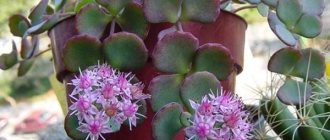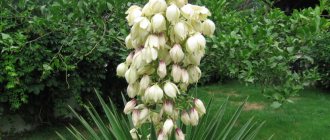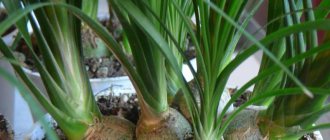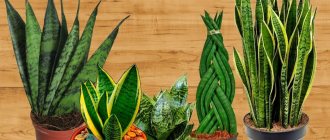Cherry laurel is not laurel. Cherry laurel differs from laurel in that, although its leaves are the same in appearance, its leaves do not have the characteristic laurel aroma. But it becomes fragrant when it blooms! This plant is used for landscaping in warm climates, but in harsh climates it can be grown as a houseplant. The leaves are similar to laurel leaves, and the fruits are similar to cherries, hence the name.
Cherry laurel (Laurocerasus) is a genus of evergreen trees or shrubs of the Rosaceae family. In indoor conditions, cherry laurel rarely grows above 1.5 m.
The fruits are used fresh and dried for food.
Cherry laurel (Laurocerasus officinalis) is commonly grown as a houseplant.
- a perennial evergreen shrub that grows to a house height of no more than 1-1.5 m. The leaves are leathery, serrated, dark green.
The flowers are white, small, very fragrant. It blooms in April-May and begins to bear fruit at the age of 4-5 years. The fruit is a juicy, sweet drupe, reminiscent of a cherry, while the fruits are edible and even very tasty
. You can make compotes and jam from them. But the seeds are inedible (they contain small amounts of hydrocyanic acid). Cherry laurel honey is poisonous.
Cherry laurel is remarkable for its undemanding nature, can be easily shaped by pruning, is shade-tolerant, and grows well in dimly lit rooms, even in corridors and on landings. For more abundant fruiting, however, a more illuminated place is required. It is frost-resistant, will winter well on an insulated loggia, and in the summer it is recommended to take it out into the air.
In winter, watering is moderate, once every 1.5-2 weeks (water so as not to let the soil dry out).
At high temperatures, it is recommended to spray the plant with water 1-2 times a day.
Cherry laurel requires light, nutritious soil; a slightly acidic universal flower soil (for example, Saintpaulia or Begonia) is suitable. Transplant every year before reaching the age of five, then once every 2-3 years.
Fertilize no more than once a month, less often is better; universal fertilizers for indoor plants are suitable.
Cherry laurel propagates by seeds; It is not easy to propagate it by cuttings and layering (although it is possible). Seeds are sown immediately after ripening; they lose their viability during storage. Shoots can appear within three months.
Cherry laurel can be attacked by scale insects and scale insects, but in general it is resistant to diseases and pests.
Indoor euonymus - description
Euonymus deserves attention as a houseplant because it is surprisingly unpretentious to the conditions of its maintenance. Unlike many other plants whose homeland is the southern countries (where euonymus specifically grows - you will find out below), it loves coolness, is unpretentious to the amount of sunlight, but at the same time pleases with a lush, spreading crown of the most luscious flowers: green, and red in autumn , then yellow, sometimes even white-green or even pink, like raspberry, euonymus.
What does euonymus look like, is it a shrub or tree?
This is a shrub, although some varieties are deliberately bred to look like bonsai: they have a thick central trunk with many thinner branches, so they resemble trees. An additional resemblance to a tree is given to it by a growth on the trunks, very reminiscent of bark.
Growing wild or located in an open-air yard, euonymus reaches four to ten meters in height. The crown is formed in different shapes: more lush, rounded, spreading, growing in width - this depends on the variety, as well as on the pruning carried out by the owner.
The main decoration of this shrub is its leaves. They are dense, shiny, elastic. There are different colors, both plain and variegated. In autumn they turn bright red, and then turn yellow. It looks very nice.
The second decoration of euonymuses is their berries. As a rule, they are a rich red color and also have an unusual shape: they seem to be held on the tips of the petals of the inflorescence. The flowers themselves (appear in late spring - early summer) are inconspicuous - small, faded with an unpleasant, pungent odor.
Homeland of the plant
Asian countries. They are most common in China, Japan, and Korea - where they are used for outdoor decoration of areas. Also grows in North America.
How quickly does indoor Euonymus grow?
This shrub grows slowly, which is why it requires quite rare replantings due to the fact that it “grew out of the pot.”
Potted plant height
Up to two or three meters.
Is Euonymus poisonous or not?
Yes, poisonous. Specifically, the sap of the plant is poisonous, and it comes from everywhere at once: from the leaves, branches, trunks, roots. Therefore, it is recommended to carefully ensure that your pet or child does not bite off a leaf from the bush.
It is necessary to replant the plant using gloves. They are especially necessary if you use a sharp tool - for example, when pruning a bush, when propagating it (for example, by cuttings) or caring during illness, when pruning of infected shoots is required.
The fruits are also poisonous, so if you keep it in the garden and it bears fruit, the berries should not be eaten.
Varieties for home cultivation
There are 2 main types of Laurel. These are the Noble and Canary options. If the first is considered more widespread and valuable, then the second is called the main botanical variety. From the description of the flower for home cultivation, it is clear that Laurel Noble is most suitable for such conditions.
How to care for Euonymus at home
In order for any plant to feel good, it needs proper care; it is important to create a favorable microclimate around the plant that is suitable for it. Please note that most developmental disorders, diseases, pests appear on indoor flowers precisely because of care errors, so it is important to immediately provide the correct one.
What to do after purchase
It is advisable to immediately transplant the new green pet into a pot with soil that is suitable for these plants (you will read more about what kind of soil they need below, in the “Transplanting” section), because store-bought, so-called shipping soil, as a rule, does not have enough nutrients to ensure the plant maintains health and, especially, development.
Also, if you already have plants, it is advisable not to place euonymus right next to them. The reason for this behavior is that there may be pests on the plant that you did not notice in the store, but they will manifest themselves at home. If you immediately place the bush next to other flowers, you can infect them, and if you leave it in quarantine for a week, then at least one plant will have to be treated, and not several.
While the new pet is in quarantine, you can prepare a permanent place for it. It is advisable to first wipe it from dust, because dust is a source of infections.
Lighting
Euonymus is undemanding in terms of lighting, which makes it very convenient for growing in northern countries like Russia. He feels calm in partial shade, does not like direct sunlight, prefers moderate, diffused light. Please note that variegated varieties with patterned leaves love light more - they need it to maintain that same pattern.
Content temperature
It is also unpretentious to temperature and tolerates cold better than heat. The optimal temperature is from 18 to 25 degrees. The exception is the autumn-winter season, the dormant period. Then the temperature cannot rise above 10 degrees (if it rises, the bush will shed its leaves), and the optimal temperature is 6-8⁰C. Therefore, an uninsulated balcony or loggia is well suited for winter maintenance.
Humidity
Here the plant is also unpretentious, since it has leathery, dense leaves that absorb moisture equally well and retain it. However, it is advisable to wipe the leaves from dust from time to time, because dust prevents them from consuming oxygen, and on hot days they can be sprayed.
How to water Euonymus
Top watering is desirable; from time to time, along with watering the soil, the foliage is moistened (the reason is explained above). Regular watering is necessary, otherwise the foliage will suffer, but excess moisture from the pan must be drained from time to time.
In summer
Abundant, such that the earthen lump is completely wet. It is advisable to water the leaves along with the soil. The soil will tell you about the need for new watering: if the top layer has dried out, it means it’s time to water the plant again.
in winter
Watering is significantly reduced. Excessive watering at low temperatures will cause root rot.
Fertilizer and feeding
Optional. If you decide to feed, then this is done once a month, no more often, exclusively in spring and summer. In autumn and winter, feeding stops completely. You can use complex mineral fertilizer.
How to use bay leaves for cooking
Bay leaf became a spice in the 1st century AD. e. And first, apples and figs were baked with bay leaves. Now they are added to almost all soups, excluding dairy ones, and to stewed meat and fish dishes. Potatoes, carrots, cabbage and legumes are boiled with laurel; prepare jellies, jellied meats and jellied meats. Bay leaves ground into powder are added to pates, minced sausages, gravies and sauces.
Essential laurel oil is an antiseptic, not superfluous when canning. Bay leaf softens the taste of pickles and adds piquancy to marinades, and in salted fish it preserves fat from oxidation. They season mead and liqueurs with it, and in the East they brew tea with laurel.
Spicy herbs are wrapped in bay leaves for the famous “bouquet garni.”
Cold pork with radish dressing, cooked with bouquet garni (recipe here)
It is recommended to add bay leaf to soups and hot dishes for just a few minutes and then immediately remove it. This way you will get the first, most delicate “levels” of essential oil, and the plant will give all its best to the dish at once. If you leave the bay leaf for the entire cooking time, then instead of a pleasant taste and aroma, for example, in soup, you will get an unpleasant and tart bitterness. And you must admit, it’s not very pleasant when a hard and already tasteless bay leaf turns out to be in the finished dish. Everyone determines the amount of seasoning according to taste or following the recipe, but William Pokhlebkin advises putting in twice as much bay leaf as recommended, but also removing it faster.
Assorted vegetables for the winter, prepared with bay leaves (recipe here)
Trimming and shaping
Pruning, as a rule, is purely aesthetic in nature, but it has a good effect on the shrub: it grows more actively, the crown becomes more luxuriant. Pruning is carried out in early spring.
You just need to pluck or cut off (with a sharp, disinfected instrument, so as not to introduce any infection into the plant’s body) the leaves that are knocked out of the crown and give the bush an unkempt appearance. Also, during pruning, it is easy to form an euonymus on a trunk, that is, as if on a trunk.
Useful properties of Laurel
By growing Laurel as a houseplant, you can get many benefits from it. Its foliage is actively used in cooking. Greens stimulate appetite and have a beneficial effect on food digestion. The essential oil contained inside has disinfectant and insecticidal properties.
It is not only the processing and ingestion of plant parts that is beneficial. It’s good to just be around this smelly “doctor.” This will help get rid of inflammation of the upper respiratory tract and prevent intestinal disorders.
The natural aroma emanating from the plant can be enhanced by watering it a couple of times a week with a solution of aspirin or glucose.
Reproduction of Euonymus
Here you will learn how to propagate euonymus in different ways (for example, by cuttings in water), how to root, and how to ensure that the cuttings are successful. In two out of three cases (cuttings and root division), you will need to separate part of the plant. To do this you will need:
- Gloves, because euonymus sap is poisonous. You may get the juice on your bare fingers and then accidentally touch your eyes or put the juice in your mouth.
- Sharp knife or scissors. They must be well sharpened and also disinfected (just wipe with alcohol) so that part of the plant can be separated in one motion, without breaking or sawing off.
- Crushed activated carbon is sprinkled on the incision to prevent infection of the bush, since separating a part from the plant is always stressful for the mother plant; it will be weakened and therefore susceptible to various types of infection.
- All cuts must be made at an angle of 45 degrees - this will help the mother plant more easily grow a new shoot in this place.
Cuttings
Suitable for all varieties of euonymus. The appropriate time for cutting cuttings is June, the first half of July, when the euonymus grows luxuriantly, is healthy and cheerful. It is better if the mother plant is at least five years old.
How it's done:
- It is necessary to select a shoot that will become the future cutting. It must have at least one internode (that is, the space between two leaves), the length of the cutting is from six to ten centimeters.
- Next you need to treat the shoot with a growth stimulator, and then place it on a mixture of sand and peat.
- Cover with plastic or glass. The sprout is left in a sunny room with a fairly high temperature, since the sprout needs high humidity and warmth.
- The sprouts will take root in one and a half to two months, by autumn.
Cuttings in water are no different from usual. You can dissolve a growth stimulator in water, this will promote the rapid formation of new roots. The plant will “drink” water, so it needs to be topped up periodically. The water should be at room temperature, settled, tap water is not suitable - it contains too many substances harmful to a young, fragile plant.
Seeds
The most difficult method, usually used by professionals and for varieties of euonymus that grow on the street. If you have a domestic euonymus, then it is better not to risk it and try cuttings.
First you need to get the seeds. To do this, the euonymus must bloom. This only happens with good care and usually outside. Then insemination is carried out, that is, using a brush several times (because it may not work the first time) the pollen is transferred from the stamens to the pistils. If you succeed, seed boxes will form in place of the flowers.
When they mature, they will begin to crack. At this point you need to cut them off and get the seeds out of there. As a rule, seeds that have just been collected germinate best, but euonymus is tolerant of cold temperatures, so it is acceptable to put them in the refrigerator until better times. In this case, before planting, you need to keep them in water for two days so that they become viable again.
Seeds must be planted in soil made of sand and peat, and mulched on top (cover with mulching material to prevent the appearance of weeds: leaves, grass, bark, straw, pine needles, sawdust, cones, gravel or a special mulching cloth). In about three months, seedlings will appear. When they have formed at least two roots of their own, they can be transplanted into a separate container.
Dividing the root
The simplest method is especially suitable for dwarf varieties (they are also used for bonsai styling), because their root system grows in breadth.
It is necessary to separate a daughter sprout no more than forty centimeters high (if it is taller, it can be trimmed), with roots no less than 1-1.5 cm in diameter. The separated sprout is planted in a separate container and immediately cared for as an adult plant.
How to distinguish laurel and cherry laurel?
The simplest thing is to pick a leaf, rub it between your fingers and smell it. If you know the scent of “laurel”, then this is laurel. Cherry laurel leaves don't smell like that.
Cherry laurel leaves are larger than those of laurel, can reach 20 centimeters, while laurel leaves are no more than 10 cm. Cherry laurel leaves have a different shape, oval. Cherry laurel has a glossy leaf on top, while laurel leaves look the same on both sides. Laurel can be used as a spice, but cherry laurel leaves contain toxic substances, so this leaf is not used as a spice (only for medicinal purposes). These plants also differ in their flowering.
Transplanting Eonimus indoors
Here you will learn how, when and why to replant euonymus.
Why is euonymus transplanted?
- After purchase, because the store-bought soil does not meet the needs of the shrub, the euonymus will not live in it for long - it will begin to hurt;
- Most often, replanting is planned, annual: because the pot has become small, as the plant develops;
- Another reason is sanitary: if a shrub is infected by pests, it is often recommended to replant it just in case to avoid re-infection through the soil.
Sequence of actions during transplantation:
- Euonymus is poisonous, so it is recommended to wear gloves.
- You need to prepare a new pot and soil (you will read below how to choose) so that it is immediately at hand.
- Place one or two centimeters of drainage and some soil mixture at the bottom of the new pot.
- Carefully remove the shrub from the old pot. Inspect it just in case: often, just during transplantation, closely examining the roots, the lower part of the plant, which is usually not so clearly visible, the owners notice pests. If you notice them, then it makes sense to return the euonymus to its place and first carry out measures to destroy the pests, and only then replant it in new soil.
- If everything is in order, then carefully place your green pet in the center of the not completely filled pot and fill in the remaining soil so that there are no air spaces left.
When can you replant?
A young plant (up to 5 years old) grows quickly, so it requires annual replanting. After five years, replanting is required only when necessary: when the root system has “grown” out of the pot (this is noticeable by the fact that the roots begin to protrude from the ground, as if trying to crawl out of the pot). Without a clearly expressed need, it is not worth replanting the euonymus, disturbing it once again. Typically, replanting is required from once a year to once every three years, it depends on the growth rate of the shrub.
A good time for replanting is early spring, when the euonymus is full of strength and ready to endure such stress. The exception is if the transplant is carried out for treatment purposes, then the season does not matter.
Priming
To make a soil mixture for euonymus, turf soil, peat and sand are used. Ratio of parts: six parts turf soil, two parts sand, one part peat. Sand can be replaced with humus and leaf soil can be added. Then the soil mixture will consist of one part of leaf soil, two parts of turf and one part of peat and humus each.
Place drainage at the bottom of the pot - crushed brick or expanded clay (special pebbles, you can buy at a plant store), since euonymus does not tolerate waterlogging.
What kind of pot is needed for euonymus
There are no special rules in choosing a pot; any pot will do, the main thing is that the root system of your shrub fits in it, and there is about one centimeter left between the roots and the walls of the pot.
Homeland of the plant
The laurel's homeland is the countries of the Mediterranean Sea and Asia Minor. Since Antiquity, the shrub has been grown in areas with hot, dry summers and wet winters. It was these green branches that were given to winners, emperors, and athletes in ancient Rome and Greece.
In the Middle Ages, laurel was a symbol of goodness and protected from lightning and evil forces. Today, laurel is found in Italy, Turkey, Greece, Guatemala, Portugal, France, Georgia, the countries of the former Yugoslavia, and southern Russia. Laurel is grown as a spice and for decorative purposes in the Caucasus and Crimea.
It is often found in resort towns in southern Russia as a shrub-hedge along sidewalks and roads.
This is a relict plant that has come down to us since the Tertiary period. In natural conditions, laurel can live for 3-4 centuries.
Diseases and pests of Euonymus and their treatment
In general, euonymus is a healthy plant with a strong immune system, if you can say that about plants, so it doesn’t have many diseases. It suffers more from pests, but pests most often appear by accident: for example, they fly from other plants or appear in contaminated soil. A favorable environment for most pests is dry and too warm air, for example, if the euonymus stands near heating devices.
Pests of euonymus
- Shields
Symptoms of appearance: leaves turn pale, dry, then fall off. Plus, you'll notice the insects themselves: tiny brown bugs with round, shiny backs.
What to do: mix any medicine containing actellik with water and treat the plant (preferably several times with breaks of a week, because scale insects are called scale insects because they have plates on their backs that protect against poisons), then cut off the damaged shoots . It is important to do this as soon as you notice scale insects, because otherwise they will multiply and the plant will no longer be saved.
- Spider mite
Symptoms of appearance: a thin, light, white coating on the lower parts of the plant, reminiscent of a cobweb. Then the leaves gradually wither, dry out and fall off.
What to do: rinse the plant under running water (the pressure should not be strong, otherwise you will damage the euonymus crown) using a soft washcloth or cloth. Then use actellik.
- Red flat tick
Symptoms: light spots on the leaves, damaged, painful appearance of the shoots.
What to do: treat with insecticide. As a rule, several treatments are required with a break of 7-10 days.
- Mole
Symptoms: The moth is visually noticeable: it is a silvery small butterfly whose wings are covered with black dots. The larvae are small, yellow-green in color. She lays eggs and the larvae eat the plant. There is also a symptom that allows you to determine that moth eggs are laid on the bark of the euonymus: the trunk is covered with a brown sticky substance.
What to do: physically remove eggs and everything associated with moths from the bush, then treat with a moth preparation.
- Aphid
Symptoms: leaves turn yellow, then curl and then fall off. This is due to the fact that aphids feed on their sap.
What to do: treat with aphids. It is recommended to do this on a regular basis for prevention purposes, because aphids are one of the most common pests of euonymus.
- Flat tick
Symptoms: deformation of leaves, white spots on them.
What to do: remove damaged shoots, treat with insecticides.
Euonymus diseases
- Drying branches
This disease is caused by a fungus, and most fungi appear in conditions of high humidity, so if your euonymus begins to show symptoms of drying out branches, you are probably overwatering it, or it is standing in an overly humid room.
Symptoms: necrosis of the bark of bush branches, then drying out and cracking. If the disease is allowed to spread, the fungus will produce spores (in cracks in the bark) and can infect other plants nearby.
What to do: treat with Bordeaux mixture, spray with preparations that contain copper, remove damaged shoots. All actions must be taken immediately, before the fungus has time to develop and produce spores.
- Ascochyta blotch
Symptoms: Brown, rust-like spots on the underside and top of the leaf. Over time, they turn white, only the edges of the leaves remain rusty.
What to do: remove damaged shoots, treat with Bordeaux mixture.
Most diseases develop in the fall, so in order to prevent them, it is important to carry out preventive measures in the summer: regularly treat the euonymus with Bordeaux mixture. It is also important to ensure that all rules for caring for the shrub are followed, since most often it gets sick when some care recommendations are not followed.
Subtleties of crown formation
When grown indoors, the Laurel is shaped to achieve aesthetics. The procedure is performed in early spring. Complex cutting, creating the shape of a ball or cone, is done once. Subsequently, you will only need to maintain the achieved state. The plant tolerates the procedure calmly, the desired shape is broken slowly.
Popular varieties of indoor Euonymus with photo and name
Due to the fact that euonymus is poisonous, it is bred mainly solely for its decorative qualities, so breeders are trying to develop more and more new varieties with a bright and beautiful crown. We have collected the most popular ones.
Winged
One of the most common, popular varieties. In autumn, this bright red-leaved bush, with a color reminiscent of raspberries or wine, immediately attracts attention and catches the eye from afar.
Fortune (Euonymus fortunei)
A variety with bicolor leaves: in summer they are dark green in the center, bordered by a wide white stripe along the edges, and in autumn the white stripe turns yellow, making the leaves almost golden.
Japanese Ecstasy
A miniature variety, the bush stretches upward, which distinguishes it from other, more spreading brethren. There is a dark green stripe in the center of the leaves, and the leaves themselves are bright gold, lemon, juicy in color.
Japanese Bravo
Very similar to “Fortune”, but the dark green part of the leaf blades is wider and the light border is smaller, but the leaves grow very densely, which is why the bush appears white from a distance.
Dwarf
The smallest variety, very different from its counterparts: the leaves are thinner, elongated, reminiscent of fern leaves, dark purple in autumn, bright green in summer.
Types of bay tree
Azorean or Canarian laurel / Laurus azorica
The height reaches 15 m, with pubescent shoots. Habitat: Azores and Canary Islands.
The leaves are dark green, oval-shaped, up to 15 cm long and 6-8 cm wide.
It produces yellow, umbrella-shaped flowers that grow from the axils of the leaves in small groups. Blooms in late spring, closer to summer.
Laurel / Laurus nobilis
The height is up to 6 m. The leaves reach a length of 20 and a width of 8 cm. It has a pleasant leather velvet feel to the touch, with a pointed end. The leaves grow on short cuttings. Blooms yellow in umbellate inflorescences from the axils of the leaves, 2 pieces each. Flowering begins in late spring.
Is it possible to keep Euonymus at home: signs and superstitions
Euonymus not so long ago became known as a houseplant and spread around the world (previously it was popular only in Asian countries - China, Japan, Korea - as an element of landscape design), so it has not yet acquired signs and superstitions, after all, for this it takes a certain amount of time. In Asian countries, euonymus was most often grown outside, outside the home, and there were no special rules associated specifically with euonymus: general rules for arranging plants according to Feng Shui were used, not related to a specific genus of plants.
But it is known that from Latin the name “euonymus” is translated as “glorious, good.” It is also sometimes called pseudo-laurel, and laurel is associated with the victories and successes of Roman commanders, who were crowned with a laurel wreath for great achievements. Therefore, it can be assumed that the euonymus has warm energy, it attracts good luck into the house and protects its owners from troubles. Or, at least, it just pleases with bright greenery.
There are several legends about how the euonymus appeared.
According to the first, it appeared thanks to the ancient Greek goddess of plants, Flora. One day she was walking through the forest, and suddenly she lost her earring and pendant. The goddess became angry at the wayward decorations and ordered them to become poisonous plants. This is how the euonymus appeared: its leaves are shaped like the pendant of a beautiful goddess, and the berries resemble her earring.
According to another legend, the euonymus was created by an evil witch as a punishment for people who had deeply offended her in some way. Later, the witch repented of her evil deed and ordered the euonymus to be not only poisonous, but also a medicinal plant (sometimes decoctions of euonymus leaves are used as a folk medicine against migraines, but this is a dangerous undertaking!). However, the witch was so exhausted by these transformations that she herself turned into a gray bird and began to flutter around the euonymus, feeding on its fruits.
According to the third legend, the euonymus and that same gray bird are lovers who were separated during life, but united after death.
More about the flower
Indoor laurel (noble) is a subtropical tree that belongs to the Laurel family. This plant is common in the Mediterranean and in some regions of Russia.
In its natural habitat, the tree can reach a height of 10 m. When growing laurel indoors, the maximum height is 3 m.
The noble tree is famous for its decorative as well as practical functions.
In the following paragraphs we will talk about how to provide indoor laurel care at home.











